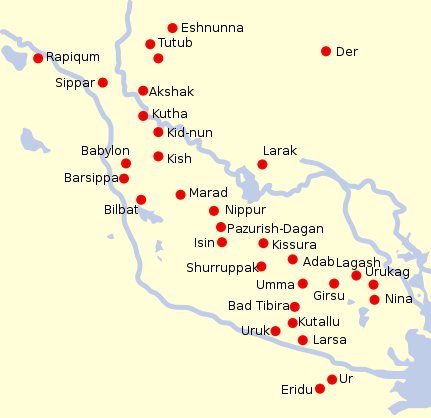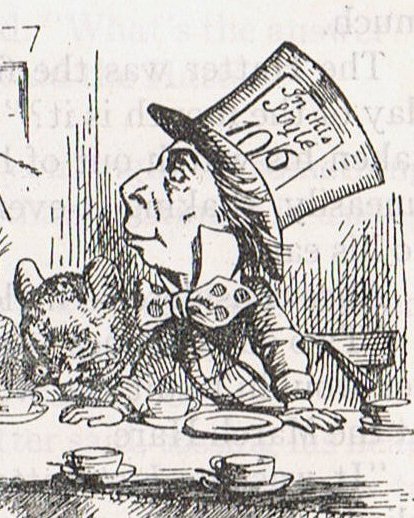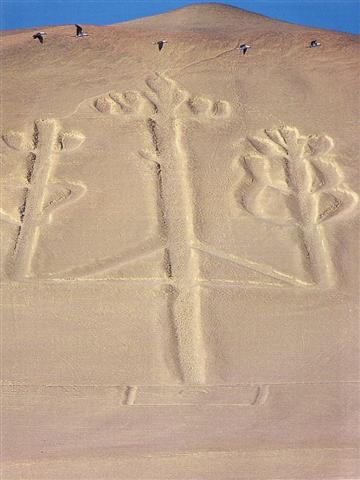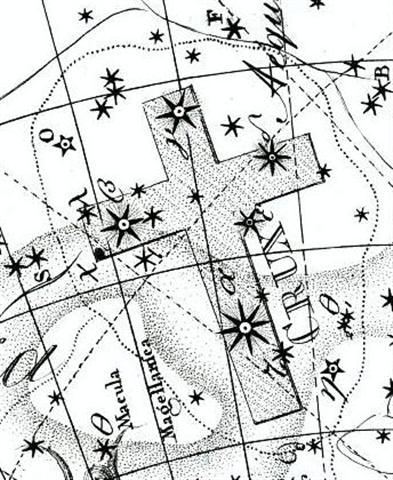By comparing the cycle of the Sun (around his year or around his
diurnal circuit) with the cycle of the Moon (the month) we
can search for a place in time corresponding to the dark night of
Hiro (at the beginning of a new month). According to the
ancient Babylonians this seems to have been where the Milky
Way began, at their Cargo Boat, because we can
perceive a dark hemisphere safely onboard:

Utnapishtim constructed a boat which would protect him from
the waters of the deluge and its dimensions were 6 * 6 * 6 = 216:
... Utnapishtim is spry enough to tell
[Gilgamesh] in great detail the story of the Deluge. He tells
how Enki-Ea has warned him of Enlil's decision to wipe out
mankind, and instructed him to build the Ark, without telling
others of the impending danger. 'Thus shalt thou say to them: (I
will ... go) down to the apsu and dwell with Ea, my
(lor)d.' He describes with great care the building and caulking
of the ship, six decks, one iku (acre) the floor space,
as much for each side, so that it was a perfect cube [a sign of
Saturn], exactly as Ea had ordered him to do. This measure
'1-iku' is the name of the Pegasus-square, and the name of the
temple of Marduk [the spring sun god] in Babylon, as is known
from the New Year's Ritual at Babylon, where it is said:
'Iku-star, Esagil, image of heaven and earth.' ...
| kua ka te ahi
i te rima aueue - te ika |
te marama kua
hua |
marama kua tuu i te kihikihi |
|
Hua.
1. Testicle. 2. Figuratively: son, hua
tahi, only son; fruits of the earth; to grow
well (of fruits). 3. To cause a fight, a
quarrel. Hua-ai, generation, as
lineage of direct descendents;
contemporaries. Huahua, coccyx of bird,
'parson's nose': huahua moa, huahua
uha. Huataru, a creeper (Chenopodium
ambiguum). Vanaga. 1. The same; ki hua,
again, to continue, to strain, to struggle, to
move, to repeat, over and above. Mq.: hua,
the same, to return, to recommence. 2. To
bloom, to sprout; flower, fruit (huaa);
huaa tae oko, huaa vahio, young
fruit; hua atahi, only son; huahaga,
fruit; mei te huahaga o tokoe kopu, the
fruit of thy body; tikea huahaga,
deceptive appearance. P Pau.: ua, to be
born; huahaga, lineage. Mgv.: hua,
to produce (said of trees, grain, etc.),
blooming time of flowers, abundance of fruit.
Mq.: hua, to produce, to bear fruit. Ta.:
ua, to sprout. Huahua. 1. Tailless
fowl. 2. Vein, tendon, line. 3. Mgv.: huahua,
pimples covering the face. Ta.: huahua,
id. Mq.: hua, tubercules. Sa.: fuafua,
abscess on hand or feet. Ma.: huahua,
small pimples. Pau.: Hua-gakau, rupture.
Ta.: áau, entrails. Sa.: ga'au,
id. Ma.: ngakau, id. Churchill.1. Fruit.
2. Egg. 3. Tā
hua = 'genealogical writing' or 'same
writing'. Fischer. |
 |
 |
 |
 |
|
Ca6-21 (161) |
Ca6-22 (Ohiro) |
Ca6-23 (Oata = Clear) |
Ca6-24 |
|
CLOSE TO THE SUN: |
|
Febr
28 (59) |
29
(365 + 60 = 425) |
March 1 (426 - 365 = 61) |
2
(31 + 28 + 2 = 61) |
|
... February 29 came to be regarded as the leap
day when the Roman system of numbering days was
replaced by sequential numbering in the late
Middle Ages ... |
|
ρ Gruis (344.0),
MATAR (Rain) = η Pegasi
(344.2), η Gruis (344.6), β Oct. (344.7) |
λ Pegasi (345.0), ξ Pegasi (345.1), ε Gruis
(345.3), τ Aquarii (345.7), ξ Oct. (345.8), μ
Pegasi (345.9) |
ι
Cephei (346.0), λ Aquarii, γ Piscis Austrini, σ
Pegasi (346.5) |
SCHEAT AQUARII = δ
Aquarii (347.0),
ρ
Pegasi (347.2),
δ
Piscis Austrini (347.4),
FOMALHAUT (Mouth of the Fish) =
α
Piscis Austrini,
τ
Gruis (347.8) |
|
'Febr 1 (32) |
2 |
3 |
4 |
|
DAY
344 |
345 |
346 |
347 |
|
CLOSE TO THE
FULL MOON: |
|
Aug
29 (80 + 161 = 241) |
30
(425 - 183 = 242) |
31 |
Sept
1 (244 = 80 + 164) |
|
no star listed (161) |
VATHORZ POSTERIOR = θ Carinae
(162.1),
PEREGRINI = μ Velorum,
η
Carinae
(162.6) |
ν Hydrae (163.1) |
no star listed (164)
ALTAIR (α
Aquilae) |
|
... This [η
Carinae] is one of the most noted objects in the
heavens, perhaps even so in almost prehistoric
times, for Babylonian inscriptions seem to refer
to a star noticeable from occasional faintness
in its light, that Jensen thinks was η.
And he claims it as one of the temple stars
associated with Ea, or Ia, of Eridhu¹, the Lord
of Waters, otherwise known as Oannes², the
mysterious human fish and greatest god of the
kingdom.
¹ Eridhu, or Eri-duga, the
Holy City, Nunki, or Nunpe, one of the oldest
cities in the world, even in ancient Babylonia,
was that kingdom's flourishing port on the
Persian Gulf, but, by the encroachment of the
delta, its site is now one hundred miles inland.
In its vicinity the Babylonians located their
sacred Tree of Life.
² Berōssōs described Oannes
as the teacher of early man in all knowledge;
and in mythology he was even the creator of man
and the father of Tammuz and Ishtar, themselves
associated with other stars and sky figures.
Jensen thinks Oannes connected with the stars of
Capricorn; Lockyer finds his counterpart in the
god Chnemu of Southern Egypt; and some have
regarded him as the prototype of Noah ...
 |
|
'Aug
2 (214 = 241 - 27) |
3 |
4 (6 * 6 * 6 = 216) |
5 |
|
DAY 161 |
162 |
163 |
164 |
Here was the Mad Hatter's t(ime)-party, which the label in his
great hat
confirms:

Because day 161 in our Gregorian calendar is June 10 (excepting
in leap years).
... The month, which takes its name from
Juppiter the oak-god, begins on June 10th and ends of July 7th.
Midway comes St. John's Day, June 24th, the day on which the
oak-king was sacrificially burned alive. The Celtic year was
divided into two halves with the second half beginning in July,
apparently after a seven-day wake, or funeral feast, in the
oak-king's honour ...
...
'Tell us a story!' said the March Hare. 'Yes, please do!'
pleaded Alice. 'And be quick about it', added the Hatter, 'or
you'll be asleep again before it's done.' 'Once upon a time
there were three little sisters', the Dormouse began in a great
hurry: 'and their names were Elsie, Lacie, and Tillie; and they
lived at the bottom of a well — '

... Sir James Frazer, like Gwion, has pointed
out the similarity of 'door' words in all Indo-European
languages and shown Janus to be a 'stout guardian of the door'
with his head pointing in both directions. As usual, however, he
does not press his argument far enough. Duir as the god of the
oak month looks both ways because his post is at the turn of the
year; which identifies him with the Oak-god Hercules who became
the door-keeper of the Gods after his death. He is probably also
to be identified with the British god Llyr of Lludd or Nudd, a
god of the sea - i.e. a god of a sea-faring Bronze Age people -
who was the 'father' of Creiddylad (Cordelia) an aspect of the
White Goddess; for according to Geoffrey of Monmouth the grave
of Llyr at Leicester was in a vault built in honour of Janus ...
This Well ought to refer to the place of St John the Dipper, at the
end of the Milky Way flow down from the Cargo Boat place (the
Tea Pot).

| rima heu ki te
vai |
te moko oho
mai |
te marama |
te kava |
manu rere |
|
Kava.
1. Sour; salty: vai kava, saltwater,
sea; te kava o te haíga, acrid underarm
smell; tagata kava - tagata kakara i te kava,
man with smelly armpits. 2. He-kava te
haha, to be thirsty. 3. To turn sour, to
become embittered, bad-tempered, exasperated
(used with manava): tagata manava
kava, bad-tempered, angry man. Vanaga.
Bitter, salt; vai kava, brackish water;
hakakava, to embalm; kavakava,
acid, sharp, bitter, salt, spiritous, vinegar,
poisonous, disagreeable; akavakava, to
make sharp; hakakavakava, to make acid. P
Pau.: kava, disagreeable to the taste;
kavakava, acid, sharp. Mgv.: kava, to
be bitter, sour, acid, salt. Mq.: kava,
bitter. Ta.: ava, bitter, acid, salt.
Kavahia: 1. Comfort, comfortable, to feast;
hakakavahia, comfort, comfortable. 2.
Repulsive (of food), disgusted; hakakavahia,
repulsion. Kavakava, rib; moi kavakava,
a house god G. P Mgv.: vakavaka, the
breast. Mq.: vakavaka, vaávaá,
rib. Ma.: wakawaka, parallel ridges. We
shall need all the available material in order
to determine the germ sense of this word. Sa.:
va'ava'a, the breast-bone of a bird;
fa'ava'a, the frame as of a slate. To.:
vakavaka, the side. Fu.: vakavaka,
the side below the armpit. Ha.: hoowaa,
to make furrows. In all these we may see the
idea of ridge or depression, or of both, as
primal (Rapanui, Samoa, Marquesas, Maori,
Hawaii), and as secondary the part of the body
where such appearances is common (Mangareva,
Tonga, Futuna). Churchill. Mgv.: kava,
the pepper plant and the drink made therefrom.
Ta.: ava, id. Mq.: kava, id. Sa.:
'ava, id. Ma.: kawa, a pepper.
Kavakava, a fish. Sa.: 'ava'ava, id.
Kavapui, a tree. Ta.: avapuhi, a
fragrant plant. Mq.: kavapui, wild
ginger. Sa.: 'avapui, id. Ha.: awapuhi,
id. Churchill. Mq.: ava, a small fish of
sweet water. Sa.. 'ava'ava, a small fish.
Ha.: awa, a fish. Kakava, burnt.
Sa.: 'a'ava, very hot. Churchill. |
 |
 |
 |
 |
 |
|
Ca10-15 |
Ca10-16 |
Ca10-17 (272 = 2 * 136) |
Ca10-18 |
Ca10-19 |
|
CLOSE TO THE SUN: |
|
June
16 |
17
(168) |
18 |
19
(535 = 365 + 170) |
20 |
|
υ
Aurigae (87.1),
ν
Aurigae (87.2),
WEZN (Weight) =
β
Columbae,
δ
Leporis (87.7),
TZE (Son) =
λ
Columbae
(87.9) |
Ardra-6 (The Moist One) /
ANA-VARU-8 (Pillar to sit by)
χ¹
Orionis,
ξ
Aurigae (88.1),
BETELGEUZE =
α
Orionis
(88.3),
ξ
Columbae (88.5),
σ
Columbae (88.7) |
η
Leporis (89.0),
PRAJA-PĀTI (Lord of Created Beings) =
δ
Aurigae,
MENKALINAN (Shoulder of the Rein-holder) =
β
Aurigae, MAHASHIM (Wrist) =
θ
Aurigae,
and
γ
Columbae (89.3),
π
Aurigae (89.4),
η
Columbae (89.7)
*48.0 = *89.4 - *41.4 |
μ Orionis (90.3), χ² Orionis (90.5) |
6h (91.3)
ν
Orionis (91.4),
θ
Columbae (91.5),
π
Columbae (91.6)
*50.0 = *91.4 - *41.4 |
|
DAY
87 |
88 |
89 |
90 |
91
(= 13 * 7) |
|
CLOSE TO THE
FULL MOON: |
|
Dec
16 (350) |
17 |
18 |
19 |
20
(354 = 12 * 29½) |
|
PTOLEMY CLUSTER = M7 Scorpii
(270.5),
GRUMIUM (Lower Jaw) =
ξ
Draconis
(270.9) |
RUKBALGETHI GENUBI (Bending Claw) =
θ
Herculis
(271.1),
ξ
Herculis (271.5),
ETAMIN (Head) =
γ
Draconis,
ν
Herculis (271.7),
ν
Ophiuchi (271.8) |
Cat's Eye = NGC6543 Draconis
(272.2),
ζ
Serpentis (272.4),
τ
Ophiuchi (272.9)
*231.0 = *272.4 - *41.4 |
Winnowing Basket-7 (Leopard)
18h (273.4)
NASH (Point) =
γ
Sagittarii
(273.7),
θ
Arae (273.8) |
Zhōngshān (274.0), π Pavonis (274.6) |
|
'Nov
19 |
20
(324) |
21 |
22
(84 + 242) |
23 |
|
DAY
270 |
271 |
272 |
273
(= 3 * 91) |
274 |
|
... As has already been mentioned, the Delphians
worshipped Dionysus once a year as the new-born
child, Liknites, 'the Child in the
Harvest Basket', which was a shovel-shaped
basket of rush and osier used as a harvest
basket, a cradle, a manger, and a winnowing-fan
for tossing the grain up into the air against
the wind, to separate it from the chaff. The
worship of the Divine Child was established in
Minoan Crete, its most famous early home in
Europe. In 1903, on the site of the temple of
Dictaean Zeues - the Zeus who was yearly born in
Rhea's cave at Dicte near Cnossos, where
Pythagoras spent 'thrice nine hallowed days'
[27] of his initiation - was found a Greek hymn
which seems to preserve the original Minoan
formula in which the gypsum-powdered,
sword-dancing Curetes, or tutors, saluted the
Child at his birthday feast. In it he is hailed
as 'the Cronian one' who comes yearly to Dicte
mounted on a sow and escorted by a
spirit-throng, and begged for peace and plenty
as a reward for their joyful leaps ...

... Gronw Pebyr, who figures
as the lord of Penllyn - 'Lord of the Lake' -
which was also the title of Tegid Voel,
Cerridwen's husband, is really Llew's twin and
tanist ... Gronw reigns during the second half
of the year, after Llew's sacrificial murder;
and the weary stag whom he kills and flays
outside Llew's castle stands for Llew himself (a
'stag of seven fights'). This constant shift in
symbolic values makes the allegory difficult for
the prose-minded reader to follow, but to the
poet who remembers the fate of the pastoral
Hercules the sense is clear: after despatching
Llew with the dart hurled at him from Bryn
Kyvergyr, Gronw flays him, cuts him to pieces
and distributes the pieces among his merry-men.
The clue is given in the phrase 'baiting his
dogs'. Math had similarly made a stag of his
rival Gilvaethwy, earlier in the story. It seems
likely that Llew's mediaeval successor, Red
Robin Hood, was also once worshipped as a stag.
His presence at the Abbot's Bromley Horn Dance
would be difficult to account for otherwise, and
stag's horn moss is sometimes called Robin
Hood's Hatband. In May, the stag puts on his red
summer coat. Llew visits the Castle of Arianrhod
in a coracle of weed and sedge. The coracle is
the same old harvest basket in which nearly
every antique Sun-god makes his New Year voyage;
and the virgin princess, his mother, is always
waiting to greet him on the bank ...
 |
| te
inoino erua |
 |
 |
|
Ca10-20
(275) |
Ca10-21 |
|
CLOSE TO
THE SUN: |
|
Solstice
(172) |
June 22 |
|
ξ
Orionis (92.5) |
Al Han'ah-4 (Brand) /
Maru-sha-pu-u-mash-mashu-7 (Front of the Mouth of
the Twins)
TEJAT PRIOR
=
η
Gemini
(93.4),
γ
Monocerotis (93.5),
κ
Aurigae (93.6),
κ
Columbae (93.8)
*52.0 = *93.4 - *41.4 |
|
DAY
92 |
93 |
|
CLOSE TO THE FULL
MOON: |
|
Solstice
(355) |
Dec 22 |
|
ι Pavonis (275.1),
POLIS
(Foal) = μ Sagittarii
(275.9)
MENKAR (α Ceti) |
η Sagittarii (276.9) |
|
'Nov 24
(328 = 355 - 183) |
25 |
|
DAY
275 |
276 |
|
tupu te raau i vai oka hia |
te moko |
te marama |
te kava |
manu kara etahi |
te mauga pu
hia |
|
Oka. 1.
Lever, pole; to dig holes in the ground with a
sharpened stick, as was done in ancient times to
plant vegetables; used generally in the meaning of
making plantations. 2. The four sideways poles
supporting a hare paega. Okaoka, to
jab, to pierce, to prick repeatedly. Vanaga. Digging
stick, stake, joist; to prick, to pierce, to stick a
thing into, to drive into, to slaughter, to
assassinate; kona oka kai, plantation;
pahu oka, a drawer. Okaoka, a fork, to
prick, to dig. Okahia, to prick. Churchill.Oka.
1. Lever, pole; to dig holes in the
ground with a sharpened stick, as was done in
ancient times to plant vegetables; used generally in
the meaning of making plantations. 2. The four
sideways poles supporting a hare paega.
Okaoka, to jab, to pierce, to prick repeatedly.
Vanaga. Digging stick, stake, joist; to prick, to
pierce, to stick a thing into, to drive into, to
slaughter, to assassinate; kona oka kai,
plantation; pahu oka, a drawer. Okaoka,
a fork, to prick, to dig. Okahia, to prick.
Churchill. |
 |
 |
 |
 |
 |
 |
|
Ca10-22 |
Ca10-23 |
Ca10-24 |
Ca10-25 (280) |
Ca10-26 |
Ca10-27 |
|
CLOSE TO
THE SUN: |
|
June 23 |
ST
JOHN'S DAY |
25 |
26 (177
= 6 * 29½) |
27 |
28 |
|
... The evening of 23 June, St. John's Eve, is the
eve of celebration before the Feast Day of Saint
John the Baptist. The Gospel of Luke (Luke 1:36,
56-57) states that John was born about six months
before Jesus; therefore, the feast of John the
Baptist was fixed on 24 June, six months before
Christmas Eve ...
 |
|
FURUD
= ζ Canis Majoris
(94.9) |
Well-22 (Tapir) /
Arkū-sha-pu-u-mash-mashu-8
(Back of the Mouth of the Twins)
δ
Columbae (95.2),
TEJAT POSTERIOR =
μ
Gemini,
MIRZAM (The Roarer) =
β
Canis Majoris
(95.4),
CANOPUS (Canopy) =
α
Carinae
(95.6),
ε
Monocerotis (95.7),
ψ1
Aurigae (95.9)
*54.0 = *95.4 - *41.4 |
no star
listed (96) |
β Monocerotis, ν Gemini (97.0) |
no star
listed (98) |
ν Puppis (99.2), ψ3 Aurigae (99.4), ψ2 Aurigae
(99.5)
*58.0 = *99.4 - *41.4
GEMMA (α Cor. Bor.) |
|
DAY 94 |
95 |
96 |
97 |
98 |
99 |
|
... The Pythagoreans make Phaeton fall into
Eridanus, burning part of its water, and glowing
still at the time when the Argonauts passed by. Ovid
stated that since the fall the Nile hides its
sources. Rigveda 9.73.3 says that the Great Varuna
has hidden the ocean. The Mahabharata tells in its
own style why the 'heavenly Ganga' had to be brought
down. At the end of the Golden Age (Krita Yuga)
a class of Asura who had fought against the
'gods' hid themselves in the ocean where the gods
could not reach them, and planned to overthrow the
government. So the gods implored Agastya
(Canopus, alpha Carinae = Eridu) for help. The great
Rishi did as he was bidden, drank up the water of
the ocean, and thus laid bare the enemies, who were
then slain by the gods. But now, there was no ocean
anymore! Implored by the gods to fill the sea again,
the Holy One replied: 'That water in sooth hath been
digested by me. Some other expedient, therefore,
must be thought of by you, if ye desire to make
endeavour to fill the ocean ...
 |
|
CLOSE TO THE FULL
MOON: |
|
Dec 23 |
CHRISTMAS EVE |
25 |
26 (360) |
27 |
28 |
|
... That the Sun-gods Dionysus,
Apollo and Mithras were all also reputedly born at
the Winter solstice is well known, and the Christian
Church first fixed the Nativity feast of Jesus
Christ at the same season, in the year AD 273 (= 3 *
91). St. Chrysostom, a century later, said that the
intention was that 'while the heathen were busied
with their profane rites the Christians might
perform their holy ones without disturbance', but
justified the date as suitable for one who was 'the
Sun of Righteousness' ... |
|
Purva Ashadha-20 (Winnowing Basket) |
KAUS BOREALIS = λ
Sagittarii
(279.3) |
ν
Pavonis (280.4),
κ
Cor. Austr.
(280.9)
*239.0 = *280.4 - *41.4 |
Abhijit-22 (Victorious)
θ
Cor. Austr.
(281.0),
VEGA = α Lyrae
(281.8) |
no star
listed (282) |
|
KAUS MEDIUS = δ Sagittarii,
κ Lyrae (277.5),
TUNG HAE (Heavenly Eastern Sea) = η Serpentis
(277.7),
SHAOU PIH (Minor Minister) = φ Draconis
(277.8),
KWEI SHE = χ Draconis
(277.9) |
φ
Oct. (278.1),
KAUS AUSTRALIS =
ε
Sagittarii
(278.3),
ξ
Pavonis (278.4),
AL
ATHFAR (The Talons of the Falling Eagle)
= μ Lyrae
(278.6)
*237.0 = *278.4 - *41.4 |
|
'Nov 26 |
27 |
28 |
29 (333) |
30 |
'Dec 1 |
|
DAY 277 |
278 |
279 |
280 |
281 |
282 |
At the base of the World Tree of Life there was a rectangular Well frame (at
the
Abyss):

... 'Two thousand miles of empty ocean and
the deeps of the Chile Basin separate Easter Island from the
west coast of South America. A due-east course would lead
voyagers from the island to make landfall in Chile. But a course
somewhat to the north of east might bring a ship eventually to
the safe haven of the bay of Paracas in Peru, which lies on a
meridian exactly 180 degrees of longitude east - and west - of
the temples of Angkor in Cambodia.
We came across the water from the north in a
small open boat, skirting the arid Balestas islands, now a
marine sanctuary, and heading for the Paracas peninsula, where
rolling sandstone hills and escarpments drop steeply into the
sea. From more than 15 kilometers off-shore we had been able to
make out the so-called 'Candelabra of the Andes', first through
binoculars and then in direct sight. It lay due south of us,
carved into a sloping cliff, looming ever larger in our field of
view as we approached.
The scholarly consesus is that this
huge earth-diagram could easily be 2000 years old and is most
likely to have been the work of the same people who created the
better-known Nazca lines which are found inland, some 300
kilometers to the south. This 'Nazca culture', about which very
little is known, is thought to have flourished from the second
century BC until about 600 AD.
The 'Candelabra' has a rectangular, box-like
base, enclosing a circle, out of which rises the representation
of a wide central vertical bar, more than 240 meters in length,
running north to south. This is crossed, about one-third of the
way up, by a triangular contraption running east to west for
some 120 meters, supporting two shorter vertical bars. All three
bars are surmounted by curious patterns generally interpreted as
flames or rays of light.
Because of its auspicious geodetic location
half-way round the world from Angkor and 108 degrees west of
Giza - sites that both 'resemble the sky' by modelling specific
constellations on the ground - we have naturally considered the
possibility that the Candelabra could be a work of celestial
imitation. What particularly invites this enquiry is the
orientation of the diagram. It is set very closely to true
north-south, the meridian of the sky, the great dividing-line
across which astronomers in all cultures have traditionally
observed the 'transits' of stars.
The Candelabra was intended by its designers
to be seen from the north. Indeed, there is no other perspective
from which it may be satisfactorily viewed: the observer must
face south towards the sloping escarpment on which it is carved.
Examining the diagram from the base up naturally draws the eyes
towards the southern sky above the escarpment, and specifically
towards the south meridian. Although it may be entirely
coincidental, computer simulations tell us that at around the
hour of midnight on the March equinox 2000 years ago - the epoch
in which the Candelabra was probably made - the constellation
known as Crux (the Southern Cross) would have been seen lying on
the south meridian at an altitude of 52 degrees. At that moment
an observer positioned on a boat as we now were, about a
kilometre north of the Candelabra, would have seen the Southern
Cross suspended in the sky directly above the great cliff
diagram ...

This could have been
the main reason why St John the Baptist was
depicted together with a tall cross, which would have been close to
the 'longitude' of the Full Moon at Christmas.
... It was last seen on the horizon of Jerusalem - 31°
46' 45" - about the time that Christ was crucified. But 3000
years previously its stars were 7° above the horizon of the
savages along the shores of the Baltic Sea, in latitude 52° 30'
...
|

















